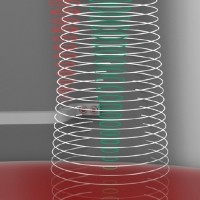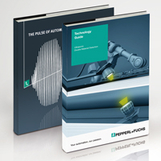Guia de Conhecimento dos Sensores Ultrassônicos (Parte 2): Influências no Feixe Sonoro

Com o software ULTRA-PROG-IR, objetos corrompidos também podem ser suprimidos usando uma programação específica de zonas cegas sem modificar o feixe. O objeto não pode mais ser detectado nesta zona cega.
Uma detecção confiável de objeto feita por um sensor ultrassônico é em grande parte determinada pela configuração correta do feixe sonoro. O reconhecimento do feixe sonoro também é referido como 'curva de resposta'. Esta curva mostra a distância na qual um determinado objeto pode ser detectado de forma segura.
A curva de resposta depende das propriedades reflexivas do objeto. Objetos com uma ampla superfície são reconhecidos mais facilmente comparando com os de superfícies menores, objetos redondos ou com propriedades reflexivas mais baixas. A Pepperl+Fuchs sabe da importância disso e agrega os diagramas do feixe sonoro para vários objetos. Por exemplo, citando uma placa padrão de 100 x 100 mm ou uma haste de 25 mm na folha de dados dos sensores ultrassônicos. A largura do feixe pode ser ajustada de diversas maneiras, concentrando o sensor exatamente no objeto alvo.
Object shape and surface
A major reason to use ultrasonic sensors is their ability to recognize most materials and surfaces. Color is of no consequence and they can detect solids, liquids, or powders. Surface properties also have no effect on detection reliability. It does not matter if the surface is rough, smooth, high gloss, transparent, dirty, wet, or dry – a high-quality ultrasonic sensor delivers precise results.
The best reflection can be reached when level, smooth surfaces are positioned at right angles to the sensor surfaces. If the angle to the surface object is not 90°, the returning sound can be deflected away from the transducer, and it will no longer be detectable. Large angle deviations are possible when recording rough or uneven surfaces. The amplitude of the reflected ultrasonic signal must be high enough to allow reliable measurement. Similarly, high levels of dust and humidity reduce the acoustic energy and can reduce the maximum range of the ultrasonic sensor.
Temperature and humidity
The range of ultrasonic signals is also influenced by the relative humidity and temperature of the ambient air. Generally speaking, the sensing range decreases with increasing temperature and increasing humidity. This reduction is not linear and differs from sensor to sensor.
Dust, rain, and snow
Sound beam modification with software
Ultrasonic sensors with adjustable sound beams allow customization of the sensing threshold. The sensing range can be adjusted to suit the object being detected via programming software or a Teach-In function. Pepperl+Fuchs’ ultrasonic sensors are programmed using the ULTRA3000, SONPROG, PACTware (IO-LINK), or ULTRA-PROG-IR software.
They enable precise control of the overall acoustic beam width. This means that the beam can be reduced in both length (axial sound beam) and width (lateral sound beam). Lateral and axial sound beam width can also be adjusted independently. This allows disruptive or reflective objects within the sensing range to be suppressed. Reducing the sound beam size allows disruptive objects or attachments on machines or in tanks to be suppressed.
Downloads de PDF: Guia de Tecnologia dos Sensores Ultrassônicos

A Pepperl+Fuchs disponibiliza vários documentos para download sobre os sensores ultrassônicos. Além de um guia de tecnologia geral sobre sensores ultrassônicos, você pode também fazer o download de um novo guia com foco na detecção de material duplo com sensores ultrassônicos. Obtenha os documentos em PDF e entenda muito mais sobre nossas tecnologias!
- Guia de Conhecimento dos Sensores Ultrassônicos (Parte 1): Tecnologia e Funcionalidade
- Guia de Conhecimento dos Sensores Ultrassônicos (Parte 2): Influências no Feixe Sonoro
- Guia de Conhecimento dos Sensores Ultrassônicos (Parte 3): Modos Diferentes de Operação
- Guia de Conhecimento dos Sensores Ultrassônicos (Parte 4): Influências na Precisão da Medição
- Guia de Conhecimento dos Sensores Ultrassônicos (Parte 5) – Instalação e Montagem Simples
- Guia de Conhecimento dos Sensores Ultrassônicos (Parte 6): Sincronizando os Sensores Ultrassônicos






 +55 11 4007 1448
+55 11 4007 1448